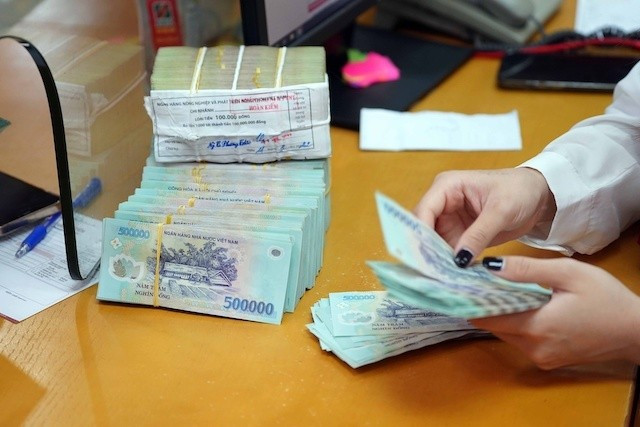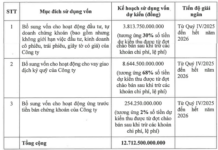Top Banks with the Highest Loan Disbursements
As of the second quarter of this year, the leading group of banks in terms of loan disbursements to customers remains the state-owned giants. BIDV tops the list with over 2.18 quadrillion VND, accounting for a 14.6% share of the total loan balance among the surveyed banks. VietinBank ranks second with nearly 1.9 quadrillion VND, followed by Agribank at 1.85 quadrillion VND, and Vietcombank at over 1.55 quadrillion VND.
Within the “Big 4” group of the industry, VietinBank leads with a growth rate of 10.3%, Agribank at 10.2%, Vietcombank at 7.4%, and BIDV at 6%.
Among private banks in the top 10 in terms of loan balances, MB takes the lead with nearly VND 880 billion, followed by VPBank at over VND 829 billion. Techcombank continues in this bloc with over VND 710 billion, while ACB records more than VND 633 billion.
A VPBank representative shared that the credit growth result was contributed by both the parent bank and its subsidiaries. Notably, GPBank recorded a 3% increase in core credit, while FE Credit also showed remarkable improvement with a 19% year-on-year surge in total disbursement and a 5.5% rise in core credit. Additionally, in response to Resolution 68 on boosting the private sector, the strategic segment of small and medium-sized enterprises witnessed a 20% increase thanks to the effective implementation of region-specific lending programs tailored to priority sectors and fields.

Capital Injection into the Economy on the Rise
Mr. Tu Tien Phat, CEO of ACB, stated that as customers’ demand for capital gradually improves and lending rates remain stable at low levels or even decrease compared to the end of the first quarter of 2025 in some banks, it creates a favorable condition for stimulating credit demand, especially for medium and small enterprises, and individual customers borrowing for housing and consumption purposes.
Brighter Prospects for the Second Half
According to the credit trend survey of credit institutions recently published by the State Bank of Vietnam, in the last six months of the year, credit institutions plan to maintain or slightly relax their overall credit standards. They will prioritize relaxing credit standards for enterprise customers and apply this to most priority sectors and fields, including green credit; lending for investment in high technology applications; lending for agriculture, forestry, fisheries, and supporting industries; lending for processing and manufacturing industries; and consumer lending; as well as lending for housing construction, purchase, and repair.
Regarding credit demand for the second half, credit institutions anticipate an improvement compared to the first six months, mainly driven by enterprise customers and the demand for investment in processing and manufacturing industries and import-export businesses.
Out of the six main sectors surveyed, the commercial and service sectors are expected to witness the highest increase in credit demand, followed by industrial and construction development, green credit, life and consumption, and agriculture, forestry, fisheries, and high technology applications.
This year, many credit institutions forecast a higher credit demand from enterprise customers compared to individuals. Short-term loans are also expected to see a higher demand increase compared to medium and long-term loans. The rising credit demand from enterprise customers in the last six months is attributed to economic growth, interest rate movements, changes in lending rates by credit institutions, and shifts in investment needs in production and business.
For individual customers, credit institutions predict that improvements in lending products will significantly impact the increase in credit demand.
According to the survey results, credit institutions have raised their expected credit growth rate for the year to 16.8% – higher than the actual growth rate in 2024. The expected deposit growth rate has also been adjusted upwards to 13.9%, and if achieved, this will be the highest rate in the last five years.
Is Real Estate and Stock Market Sucking Up Huge Capital from Banks a Concern?
The surge of credit into the stock market is a temporary blip, according to analysts. However, the real story lies in the significant flow of credit into the real estate sector, which warrants closer attention.
Unlocking the Secrets to Effective Real Estate Investment: A Comprehensive Guide by the Ministry of Construction
The growth rate of credit for real estate across many banks has reached an impressive 20-30%, an astounding threefold increase compared to the overall credit growth rate of the system. The Ministry of Construction suggests that the State Bank should develop a special credit package for reasonably priced housing to further stimulate credit growth.
Proposed Title: Petition to the State Bank to Lower the Deposit Interest Rate Cap
To continue fueling credit growth from now until the end of the year and to support businesses and boost economic growth, several banks have proposed a number of measures related to capital mobilization and interest rates, among other things.
Unlocking the Secrets to Effective Real Estate Investment: A Comprehensive Guide by the Ministry of Construction
The growth rate of credit for real estate across many banks has reached an impressive 20-30%, an astounding threefold increase compared to the overall credit growth rate of the system. The Ministry of Construction suggests that the State Bank should develop a credit package for reasonably priced housing to further boost this credit growth.










































